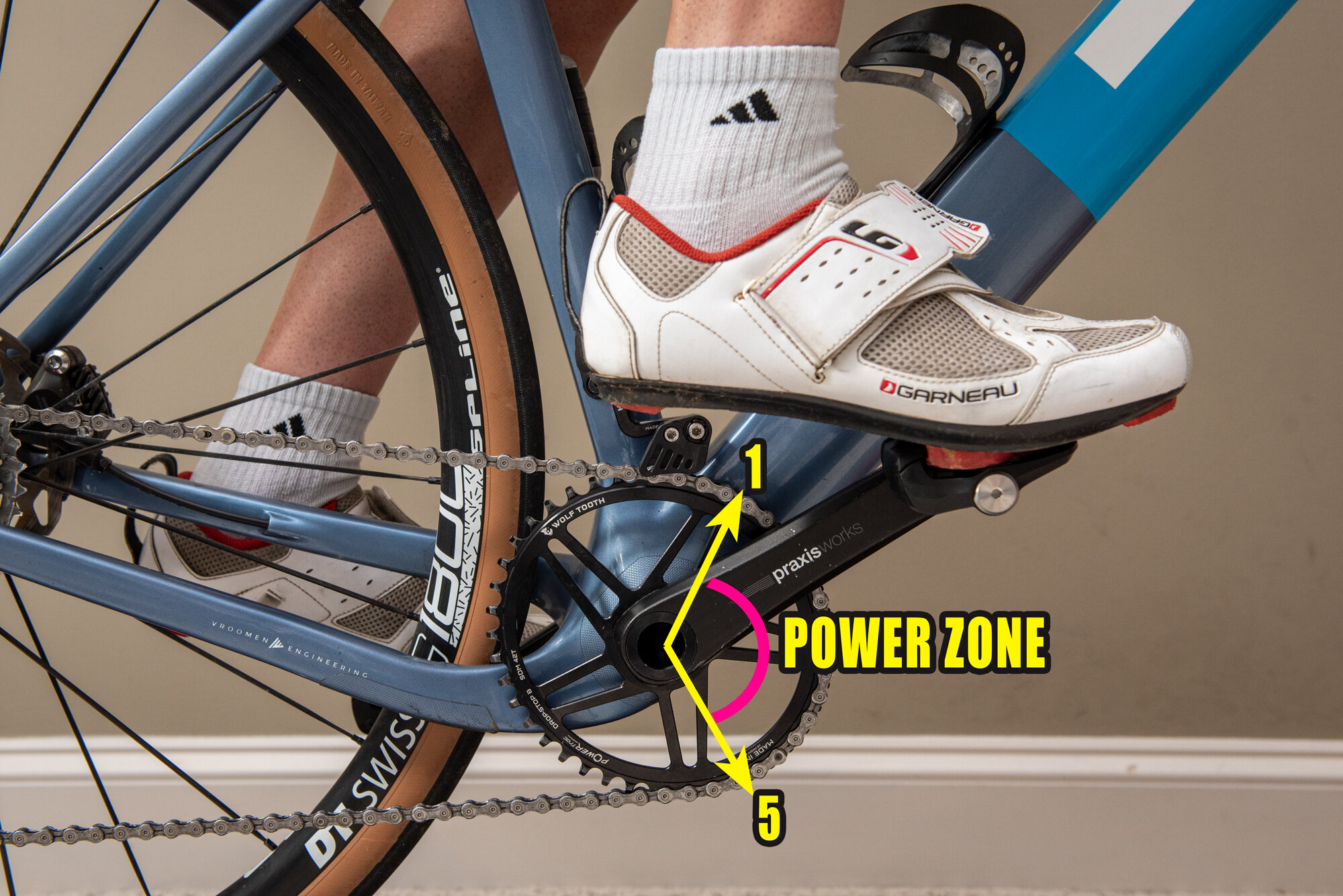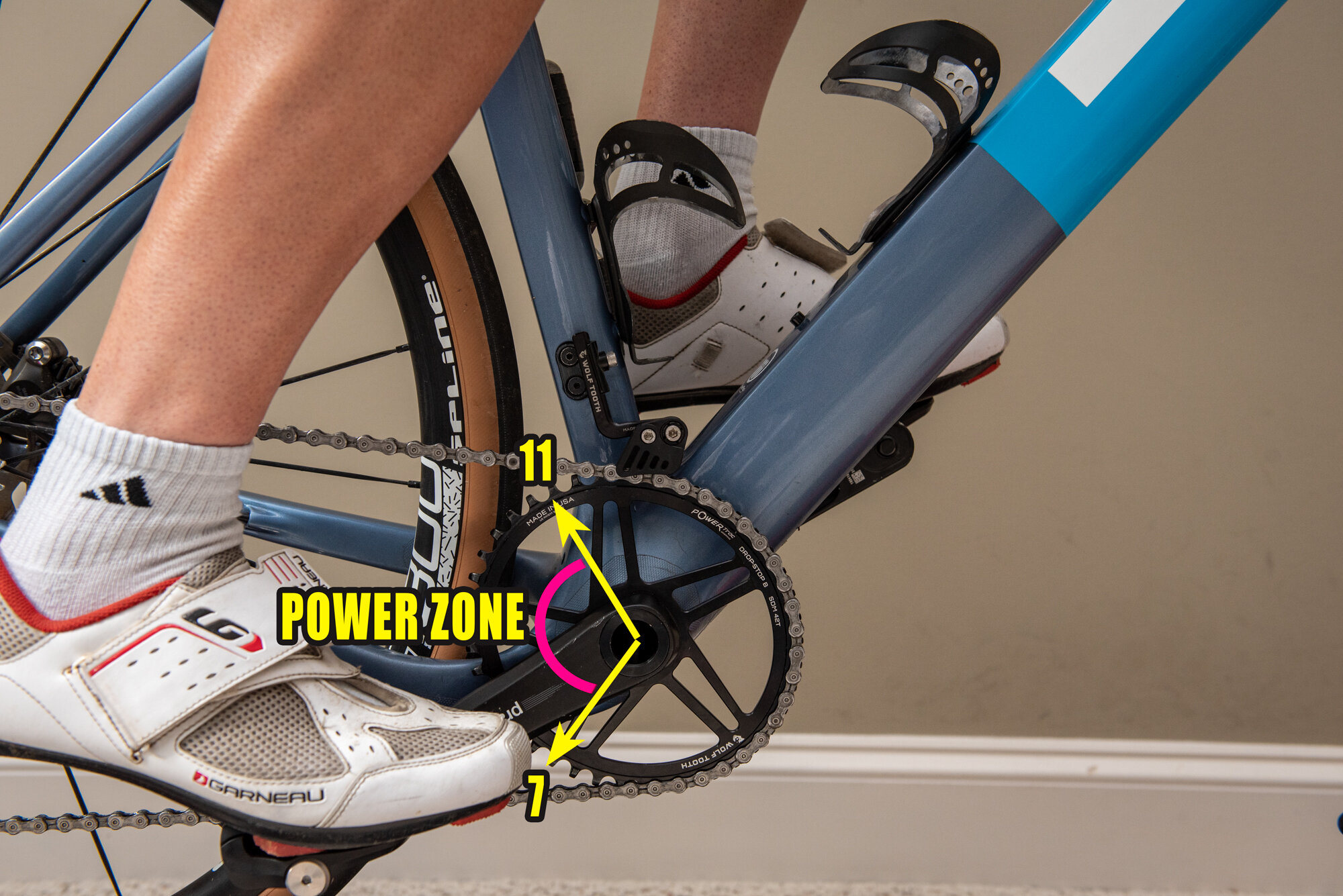Wolf Tooth PowerTrac Elliptical (Oval) Chainring Review
Disclaimer: This post contains affiliate links, through which we earn a commission.
Once in a while, a product comes along that fundamentally changes the way you ride a bike. I know this sounds dramatic, but when altering the very core of a bicycle’s design (round shapes), things get interesting. Switching from a traditional round chainring to the more controversial oval chainring surely classifies as changing up the foundation of cycling. I’ve had the opportunity to ride a Wolf Tooth PowerTrac Elliptical (PTE) chainring over the last few weeks and I’ll provide you with my thought and experiences about this product throughout this article. I went into this one somewhat skeptical, but in the end, the results speak for themselves. This is going to get a bit technical at times, so put your bike nerd thinking cap on and let’s get into this noteworthy bike product!
Why Oval?
I’ll start this section off with a fun fact about myself. Since the end of high school, until a few years ago, I worked as a spinning instructor (Indoor Cycle trainer) on the side. One of the key instructions that I gave to riders attending my classes was to “push and pull” on the pedals. I reinforced this instruction multiple times per class to help remind attendees to not only exert downward force on the pedals, but to also engage their calf muscles while the pedals moved through the back portion of the cycle. When clipped into pedals (or while using toe straps), it becomes so much easier to be efficient, utilizing both the quads (for pushing down) and the calves (for pulling up) during the pedal stroke.
This “full circle” pedaling style is a technique that many new riders struggle to adopt, because it was never the way we were taught to ride a bike. My first bike surely didn’t have any clip-in pedals and this means that I’ve developed the habit (from an early age) to merely stomp down on the pedals, utilizing only my stronger and more dominant quad muscles to put force into the pedals.
This brings us to the need for an oval chainring, because my indoor cycle class instruction of “pushing and pulling” on the pedals, actually only covers part of the pedal revolution. When you think of the full pedal revolution as the face of a clock, it becomes easy to visualize the different phases of the pedal stroke. When pushing down on the pedals between the 1 and 5 o’clock position, the quad muscle is working to exert power onto the pedals, while between the 7 and 11 o’clock positions the calf muscle can pull up on the pedal. Let’s use Wolf Tooth’s terminology and call these phases the “Power Zone” of the pedal revolution.
Those phases obviously don’t cover the full circle, so what about the top (11 to 1 o’clock) and bottom (5 to 7 o’clock) parts of the pedal revolution? Biomechanically, during these parts of the pedal revolution, a rider is not able to apply as much power to the pedals, since neither the quad, nor the calf muscle can dominate the stroke. Wolf Tooth calls these phases the “Recovery Zone” and it’s precisely here where one stands to gain some benefit when using an oval ring.
When the foot is at the very top or very bottom of the pedal revolution, one is far more dependent on the momentum of the pedal to move you through what is sometimes referred to as dead-spots. Wolf Tooth refers to the dead-spot at the 12 o’clock position as the top dead center (TDC). Without the momentum of the pedal arm swinging up from the back end of the revolution, it becomes very difficult to “roll-over” the top portion of the cycle. Similarly, when the foot is at the bottom dead spot (6 o’clock position), the extended nature of the leg muscles provides little leverage to drive the pedal stroke around the bottom end of the cycle.
Some cycling coaches will prescribe drills to help riders overcome these inherent biomechanical limitations. Perhaps you’ve heard about how one is supposed to “scrape the mud off of the bottom of your shoe” to try to power through the bottom dead spot. Another drill that can help simulate this action is to make use of a kick scooter where the act of pushing off can help train the body to become more efficient when the leg is in an extended position.
If you want to get really advanced with visualizing the inherent flaws in your pedaling technique, then I can highly recommend that you take a ride on a Wattbike. At a cycling expo a few years ago, I got the chance to hop onto a Wattbike and it’s really helped to understand the way that I pedal. What makes a Wattbike so special is its ability to measure power throughout the pedal stroke by taking a power reading every few milliseconds. This provides a view of one’s pedal stroke and the efficiency during each revolution, a chart that Wattbike refers to as the Polar view. There is an easy-to-understand article on Wattbike’s website that breaks down how to interpret the different polar views. What you’ll note from their graphs is how beginner and intermediate riders, in particular, fail to maintain good momentum throughout each pedal stroke, leading to poor balance between the power and recovery phases. This brings us back to the oval chainring and its ability to assist a rider during the recovery phase, the part of the pedal revolution where most riders need some assistance. To see how this works, let’s take a closer look at the oval design.
The Oval Design
In principle, the idea behind an oval ring is fairly simple. If you are more efficient during the Power phase of the pedal stroke, and less efficient during the Recovery phase, then why not make it easier to turn the crank during the part of the revolution lacking some power. How do you do this? Well, you flatten out the traditional round shape of a chainring. This oval / elliptical shape, if orientated in the correct manner, provides a section of the ring that requires a greater amount of torque to turn and another section which is flatter (smaller circular radius) and requires less torque to turn. This means that with the oval shape orientated correctly, the ring can better match your power output, since the biomechanical limitations that I mentioned earlier are provided with more favorable power-output conditions. The quad and calf muscles can now exert torque onto the pedals when a bigger circular radius needs to be overcome, while a smaller circular radius is present in the dead-spots. You don’t have to be a physics major to appreciate the ingenuity behind this design change.
1. Timing
While I’ve mentioned the importance of the orientation of the ring a few times, all the complicated math that sits behind that orientation has already been done by Wolf Tooth. All you need to do is to line up the “Crank arm” graphic to the crank and you’ll be all set.
There is, however, one metric of which to take note, called “timing.” Like the timing of a car’s engine, so too you want the power from your legs to fire / engage at the correct time, in order to be most effective. The timing of a chainring can be set by adjusting the orientation, to allow the larger diameter of the oval shape to engage with the chain during the optimal point on the downstroke. Wolf Tooth’s PowerTrac chainrings come with a set timing number (112°) and this is not a setting that you’ll need to configure for yourself.
Timing is measured by the angle from the top dead center (TDC) as illustrated in the image below:
The timing of the ring is one area of comparison between manufacturers, since they differ (slightly) in terms of what is regarded as “the optimal point” of engagement. Some chainrings engage sooner, while others engage later during the pedal revolution. For reference, I’ll make some comparisons between three oval chainring brands: Wolf Tooth, Garbaruk and Absolute Black. In the table below, you’ll see how timing differs from one manufacturer to the next.
The Wolf Tooth chainring is the only oval ring that I’ve ridden to date, leaving me with no meaningful comparison between different chainring timing settings. The 112° timing on this ring worked perfectly for my needs and I see no reason to require any adjustments.
2. Ovality Percentage
I oversimplified the oval shape earlier by stating that it’s a mere flattened out circle, but in reality, there is another metric that can be used to capture the exact shape of the chainring: Ovality. When designing the oval shape of a chainring, various levels of ovality can be achieved, which will certainly alter the way they perform and feel.
In order to provide a more natural feel to the pedal stroke, Wolf Tooth opted for a shape with 10% ovality. The ovality metric is yet another area of comparison between the different chainring manufacturers and you’ll be able to tell from the table below how Wolf Tooth’s chainrings compare with some of the other brands on the market.
As mentioned before, the Wolf Tooth PowerTrac Elliptical chainring has been my only venture into the world of oval rings to date, making it difficult to compare the various levels of ovality. While I have no other reference point at this stage, I will state that the following line from Wolf Tooth’s website helped to persuade me to give oval chainrings a go: “Our proprietary design means a slightly less ovalized ring with less aggressive timing than competitors’ versions; any change to your pedal stroke is unnoticeable for most riders, but they still provide the power and traction benefits inherent to elliptical chainrings.”
The key phrase from that statement is the “less ovalized shape and less aggressive timing” when compared to other brands on the market. As someone who has been somewhat skeptical about oval rings in the past, this breakdown helped to explain how Wolf Tooth’s elliptical rings differ and how it could provide the perfect entry point into the world of oval chainrings. With that reassurance, I decided to give it a go and I’m sure that my first question, and the thing that made me most skeptical, must surely be top of mind right now – does it feel oval?
Does it Feel Oval?
The straightforward answer to this question is no. Not in the least. This really is one of those things that can play a massive trick with the human mind. If you look at the way an oval chainring spins around, then you’ll be excused for thinking that the ride feel has to be affected. The odd manner that the chainring expands and shrinks with each revolution just doesn’t look natural, but I can assure you that the feel on the pedals is actually very normal.
In fact, I’ll go as far as to say that the pedaling actually feel more natural with an oval ring when compared to a standard round chainring. All the biomechanics that I touched on earlier truly work together to help smooth out each pedal stroke. It feels natural, it feels smooth and overall, it just leaves you with a sense that you are far more efficient with transferring power into the pedals. The dead-spots can be overcome so much better, providing additional momentum and power to utilize during the power phase of the stroke.
I’ve been amazed by the difference that this chainring has made to my pedaling style and I honestly think that I’ll be riding with oval more permanently in the future. Currently, I have the Wolf Tooth PowerTrac Elliptical chainring fitted to my gravel bike and a standard round Wolf Tooth chainring fitted to my road bike. I’ve switched between the bikes on consecutive rides and from a pedaling style perspective, I much prefer the feel that I get with the oval ring. I never thought that I would ever give oval chainrings a try, let alone convert wholeheartedly over to this type of ring. It’s simply been that impressive!
Benefits of Riding Oval
The benefit that can be gained from riding with an oval chainring will differ from rider to rider, depending on your existing pedaling technique. If you refer back to the Wattbike polar views that I mentioned earlier, then you’ll be able to tell that some riders (Elite level) are better able to produce power during the recovery phase, while others struggle during this part of the pedal revolution.
While conducting my research on oval chainrings, I found an interesting point that was made on Absolute Black’s website when it comes to the benefits on offer. The quote from the page is stated below and perfectly captures the idea that beginner and intermediate riders stand to gain the most from making the switch to an oval chainring:
“One of the key reasons the benefits of oval chainrings have historically proven hard to prove in lab tests, is because they were nearly always done using professional riders – as a user group they are the least likely to gain a performance increase from a switch to oval, as their pedaling is already close to perfection. Where ovals shine however is with the rest of us, who ride for pleasure and not for a job. Simply 99% of road cyclists will benefit from having oval chainrings on their bikes.”
They specifically refer to road riding in that analysis, but the application of oval chainrings extends well beyond the road. As mentioned earlier, I fitted my Wolf Tooth Elliptical chainring to my gravel bike and I feel that it excels the most on the off-road terrain. An oval chainring reduces the required torque (through a smaller circle radius) in the recovery phase, ultimately leading to a smoother pedal stroke all around. A smoother pedal stroke leads to better traction, especially on loose surfaces like gravel.
If you’ve ever been on a gravel (or MTB) ride during which you were faced with an incredibly steep incline, then you’ll know that it’s often required to stay seated in order to maintain traction. One’s power output is often very uneven when climbing out of the saddle. The loss of traction in those scenarios comes from the irregular power transfer that occurs while throwing your body weight into each revolution. In the same way that sitting down in the saddle can help to smooth out the stroke, leading to better traction, so too an oval chainring can help to maintain better traction by smoothing out the power transfer even more.
I’ve seen the greatest benefit from the Wolf Tooth oval ring with steep and / or steady gravel climbs, but even on smooth and flat road surfaces, there has been a noticeable difference in the way that I pedal. I could easy hold a steady rhythm while using a gear that is one shift harder than what I normally ride. Whereas I would normally ride a 40T front, 11T rear combo (3.63 ratio) on my road bike’s round ring, I could now easily hold a 42T front, 11 rear combo (3.81 ratio) using the oval ring on the same sections of road.
To date, I’ve accumulated around 1000kms (~620 miles) of riding with the Wolf Tooth PowerTrac Elliptical chainring and the benefits have become more apparent with each passing ride. I’m planning to increase my road bike’s chainring from the current (round) 40T size to a 46T size in the future and the Wolf Tooth oval chainrings will be on the top of my list.
Is Oval for You?
There are quite a few types of riders who stand to benefit from oval chainrings, and as I’ve pointed out in the previous section, just about anyone with a less-than-perfect pedal technique can stand to benefit from them. Let’s discuss some of the potential benefits for specific off-road riders.
Mountain bikers have been early adopters of oval rings and we’ve seen them used in this field for quite some time. The steep climbs that require additional traction can be found on just about every mountain bike ride, and I suspect that it’s for this reason that so many mountain bikers prefer to use oval rings.
Gravel riders and bikepackers are perfect candidates for oval rings, as the off-road terrain demands additional traction on loose and slippery gravel surfaces. Most of the bikes in this field are also already utilizing a 1x drivetrain, making them perfectly geared to accommodate a chainring that was designed to be used for a 1x setup.
Single speed riders, in my opinion, should strongly consider the benefits of an oval ring. Wolf Tooth has an excellent illustration on their website that highlights how their oval rings can function almost like a “two-in-one-chainring,” since the difference in feel between the power and recovery phase compares to a brief gear shift. They state that a 34T PowerTrac Elliptical ring can feel more like a 36T (round) ring during the power phase and more like a 32T (round) ring in the recovery phase. While I’ve never raced on a single speed bike, I can only imagine that any “shift” is greatly appreciated with only one gear on the bike.
Stand-Out Features of Wolf Tooth Chainrings
I mentioned earlier how the shape of the Wolf Tooth chainring made it less daunting to try out an oval ring for the first time. Wolf Tooth's less aggressive timing and less ovalized shape made moving over to an oval chainring less of an adjustment. It didn't affect my natural pedaling style as much as I had expected, and instead seemed to work with my technique rather than just alter it. There are, however, a few more features to the Wolf Tooth chainring that I found to be extremely beneficial.
The first comes in the form of their "Drop-Stop" chainring tooth design. Drop-Stop is Wolf Tooth's take on a narrow-wide tooth layout that can help keep the chain securely in place. I've been testing the Wolf Tooth PowerTrac Elliptical chainring on my gravel bike and throughout all the riding, including some gnarly gravel sections, I haven't run into any dropped chain issues. It's a neat feature that adds some peace-of-mind to any gravel bike setup and I've been very pleased with it to date.
A second point to note with the Wolf Tooth chainring is the fact that it's manufactured in the USA. Given the current global environment where bike parts are in massive shortage and logistics around the world are severely restricted, having a local supplier counts for a lot. It was a welcome benefit to know that my Wolf Tooth chainring only traveled from Minnesota to Virginia, rather than shipping all the way across the world.
Wrap-Up
I’ve ridden bikes competitively for 20 years and never before have I considered adjusting the fundamental way in which I pedal (i.e., round circles). To alter this core action of riding a bike almost feels wrong and seems to make no intuitive sense, but after diving into the world of oval chainrings, I’m beginning to understand the logic behind this design. I’ve thoroughly enjoyed my time with the Wolf Tooth Powertrac Elliptical chainring thus far, and I’ll certainly continue to use this product in the future. My pedaling style feels more natural and I feel like the power transfer into the pedals is more balanced. I’m climbing stronger than ever, and although this could come down to a variety of factors, the addition of an oval chainring seems the most obvious. There will be critics out there that will write-off any additional benefits from an oval chainring as a placebo-effect or point to studies that have discredited the benefits of an oval chainring. At the end of the day, I can’t make any claims beyond what I’ve experienced, but to date, those experiences have been nothing but positive. I can certainly recommend that you give oval rings a try. It’s worked for me, and I’m sure there are lots of other riders who also stand to benefit from them.
- Wiehan
Tell us! Have you given oval chainrings a try? If so, what do you think? Let us know in the comments below!
























